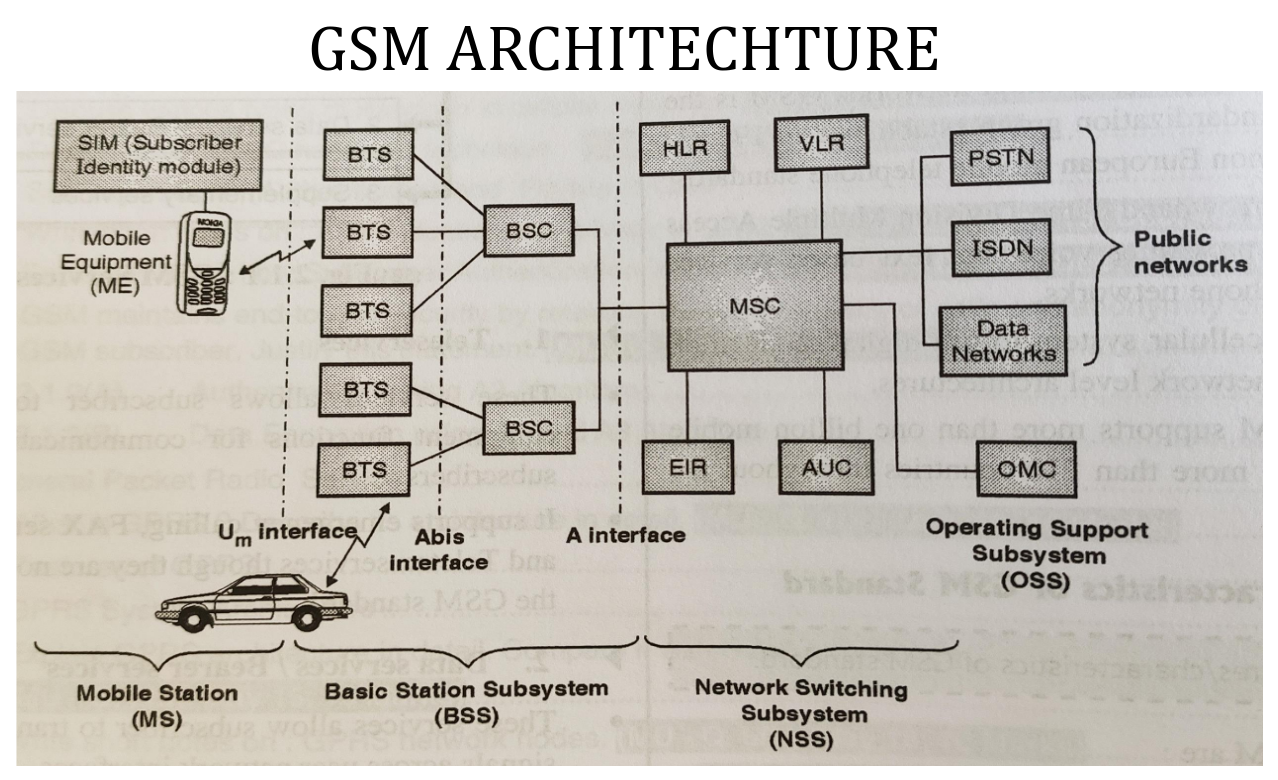
GSM Architecture Overview
The GSM architecture is divided into three main subsystems:
-
Mobile Station (MS)
-
Basic Station Subsystem (BSS)
-
Network Switching Subsystem (NSS)
Additionally, there is the Operating Support Subsystem (OSS) to manage and maintain the network.
1. Mobile Station (MS)
The Mobile Station is the user’s device, made up of two parts:
-
A. Mobile Equipment (ME):
-
Portable or vehicle-mounted handheld device (e.g., a mobile phone).
-
Uniquely identified by an IMEI (International Mobile Equipment Identity) number.
-
Used for voice and data transmission.
-
Monitors power and signal quality of surrounding cells to assist in smooth handover between cells.
-
Can send 160-character long SMS messages.
-
-
B. Subscriber Identity Module (SIM):
-
A smart card containing the IMSI (International Mobile Subscriber Identity) number.
-
Enables users to send and receive calls and use other subscriber services.
-
Protected by a password or PIN.
-
Contains encoded network identification details.
-
Portable: can be moved from one mobile device to another.
-
2. Basic Station Subsystem (BSS)
The BSS is responsible for communication between the Mobile Station and the Network Switching Subsystem.
-
Base Transceiver Station (BTS):
-
Facilitates wireless communication between the mobile device (UE) and the network.
-
Handles radio signals to and from the mobile station.
-
-
Base Station Controller (BSC):
-
Controls one or more BTSs.
-
Manages radio resources including setting up radio channels, frequency hopping, and handovers.
-
Acts as a link between the BTS and the Mobile Switching Center (MSC).
-
3. Network Switching Subsystem (NSS)
The NSS handles the core network functions such as call routing and subscriber management.
-
Mobile Switching Center (MSC):
-
Primary node for routing voice calls, SMS, and other services (conference calls, fax, circuit-switched data).
-
Interfaces with other networks such as PSTN, ISDN, and data networks.
-
-
Home Location Register (HLR):
- Central database that contains subscriber information, such as user profiles and service permissions.
-
Visitor Location Register (VLR):
- Temporary database storing information about subscribers currently in the MSC’s service area.
-
Authentication Center (AuC):
- Validates SIM cards attempting to connect to the network to ensure security.
-
Equipment Identity Register (EIR):
-
Maintains a list of valid IMEI numbers.
-
Helps identify stolen or unauthorized mobile equipment.
-
4. Operating Support Subsystem (OSS)
-
Operations and Maintenance Center (OMC):
-
Connected to all switching and base station equipment.
-
Responsible for monitoring and maintaining the network to ensure smooth operation.
-
Interfaces in GSM Architecture
-
Um Interface: Air interface between Mobile Station (MS) and BTS. It is called Um because it corresponds to the mobile analog of the ISDN U interface.
-
Abis Interface: Connects the BTS to the BSC within the Basic Station Subsystem (BSS).
-
A Interface: Provides communication between the BSS and the MSC in the Network Switching Subsystem (NSS).
Public Networks Connectivity
The MSC connects the GSM network to external public networks such as:
-
PSTN (Public Switched Telephone Network)
-
ISDN (Integrated Services Digital Network)
-
Data Networks